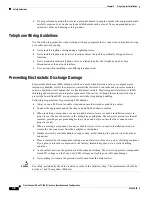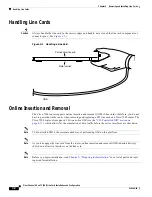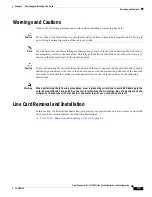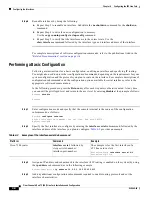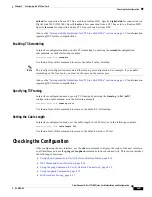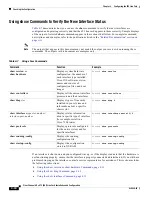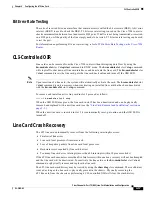
4-7
Clear Channel 6-Port T3 (DS3) Line Card Installation and Configuration
OL-3449-02
Chapter 4 Configuring the 6T3 Line Card
Configuring the Interfaces
Setting the Sending and Receiving Rate
The local and remote DS3 ports must also agree on whether to use a subrate or fullrate sending and
receiving rate, because the speed of the sending and receiving rate is regulated by the DSU mode. If the
sending and receiving rates do not match, they will not work. Subrates are specific to DSU modes and
must be configured appropriately. The subrate sending and receiving rate is slower and less expensive
than the faster, more expensive, fullrate. You can synchronize the local and remote DS3 ports sending
and receiving rates by entering the dsu remote interface configuration command.
Configuring the DSU Bandwidth Range
The DSU bandwidth range is from 0 to 44210 kbps. The local port and the remote port must have
matching configuration. Therefore, if you reduce the effective bandwidth to 3000 on the local port, you
must do the same on the remote port by entering the dsu bandwidth interface configuration command.
In interface configuration mode, reduce effective bandwidth (range of 0 to 44210 kbps) by entering the
dsu bandwidth configuration subcommand, as in the following example:
Router(config-if)# dsu bandwidth 3000
Use the
no
form of this command to return to the default, 44210.
Note
The local port configuration must match the remote port configuration.
Enabling Payload Scrambling
Payload (data) scrambling converts the data received by the local or remote DS3 ports from the Digital
Link, Kentrox, and Larscom third-party DSU vendor modes as well as the default, Cisco mode. The
Adtran DSU mode does not support payload scrambling.
To enable payload scrambling on the local and remote DS3 ports, you must enter the scramble interface
configuration command. If you do not enter the scramble command, payload scrambling remains
disabled by default on the local and remote DS3 ports.
Configuring Cyclic Redundancy Checks
Table 4-6
summarizes cyclic redundancy check (CRC) commands. For more information, see the
remainder of this section.
Table 4-6
CRC Commands
Purpose
Command
Example
Further Information
Enable 32-bit CRC.
crc size
The example enables 32-bit CRC on a serial
interface:
Router(config)# interface serial 3/0
Router(config-if)# crc 32
“Selecting a DSU Mode”
Return to default
16-bit CRC.
no crc size
The example disables 32-bit CRC on a serial
interface and returns to the default 16-bit
CRC:
Router(config)# interface serial 3/0
Router(config-if)# no crc 32
“Selecting a DSU Mode”


